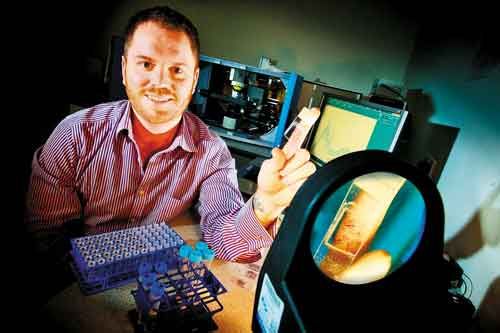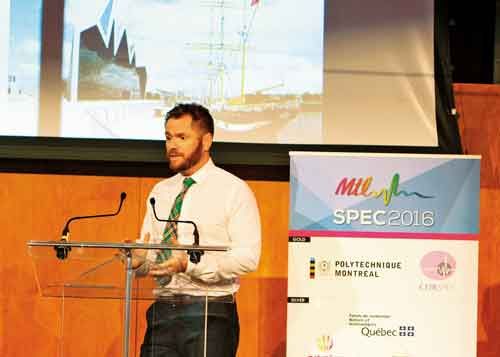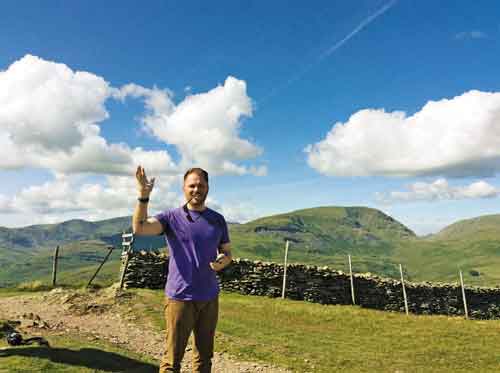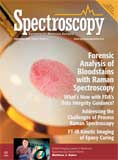The 2016 Emerging Leader in Molecular Spectroscopy Award
Spectroscopy
Matthew J. Baker, the winner of Spectroscopy’s inaugural Emerging Leader in Molecular Spectroscopy Award, is passionate about solving clinical problems with vibrational spectroscopy.
The winner of Spectroscopy’s inaugural Emerging Leader in Molecular Spectroscopy Award is highlighted.
Matthew J. Baker, a senior lecturer in chemistry at the University of Strathclyde, in Glasgow, has won the inaugural Emerging Leader in Molecular Spectroscopy Award, which is presented by Spectroscopy magazine. This new annual award recognizes the achievements and aspirations of a talented young molecular spectroscopist, selected by an independent scientific committee. The award will be presented to Baker at the SciX 2016 conference in September, where he will give a plenary lecture and be honored in an award symposium.
Spectroscopy created this award as a way to recognize and encourage leaders of the next generation of molecular spectroscopists. The achievements that Baker has already made at this early stage of his career make it clear that he is indeed a standout in the field. His work also makes the future of the field look very bright.
An Early Focus on Biomedical Applications of Vibrational Spectroscopy
At Strathclyde, Baker leads interdisciplinary research rooted in fundamental studies to advance the use of analytical chemistry to real-world problems, particularly in biomedical and clinical applications. His main focus is the development of spectroscopic and spectrometric molecular pathology techniques, disease diagnosis, and detection of pathogenic bacteria and toxic chemicals.

Baker in his lab holding a slice of brain tissue.
Baker’s focus on the use of vibrational spectroscopy for biomedical use was already well underway during his studies for his master’s degree in chemistry, which he received in 2004 from the University of Manchester Institute of Science and Technology (UMIST). Through his research on using Fourier transform infrared (FT-IR) microspectroscopy and multivariate analysis for diagnosing prostate cancer, he was able, for the first time, to correlate FT-IR spectra with the Gleason score (a measure of the microscopic appearance of a prostate tumor) and the clinical stage of the tumor at the time of biopsy.
Peter Gardner, a professor of Analytical and Biomedical Spectroscopy at the University of Manchester, taught Baker in his first and final years at the university and was his academic advisor during his year in industry. “I supervised his final year project, so I guess I can claim to have set him off on his path to using IR spectroscopy,” said Gardner. “Although I was not his PhD supervisor, he did work in my lab for a period of time and did his first work on blood serum, which now forms a major part of his research.”
Baker’s doctoral studies also focused on cancer diagnosis under the supervision of Dr. Nick Lockyer-in tissues and cells-but in this case using time-of-flight (TOF) secondary ion mass spectrometry (MS) combined with multivariate analysis and pattern recognition. He received his PhD from the Department of Chemical Engineering and Analytical Science at the Manchester Interdisciplinary Biocentre at the University of Manchester, and his thesis was a collaboration with the Paterson Cancer Research Institute.
In 2011, Baker received a PGCert (postgraduate certificate) in International Studies from Staffordshire University. The certification covered international relations in the 20th century and diplomacy and the global world, which helped Baker understand the international arena he was working in.
After receiving his PhD in 2007, Baker held numerous fellowships and research positions. First, he received a Life Sciences Interface fellowship from the UK’s Engineering and Physical Sciences Research Council (EPSRC). This fellowship focused on biomedical applications of vibrational spectroscopy, mass spectrometry, and imaging and took him from the Manchester Interdisciplinary Biocentre in the UK, to the Robert Koch Institute in Berlin, Germany, and to Harvard Medical School in Boston, Massachusetts. During the same period, he had research fellowships at the Robert Koch Institute and at Harvard Medical School and Brigham & Women’s Hospital (also in Boston). At the Robert Koch Institute, he used vibrational spectroscopy combined with multivariate analysis-pattern recognition for the analysis of prostate cancer tissue; at Harvard medical School, he focused on multi-isotope imaging MS for the analysis of prostate cancer cell lines, prostate cell lines, and stem cells.
Rohit Bhargava, a professor at the University of Illinois who is well known for his research on biomedical imaging using vibrational spectroscopy, praised Baker’s early studies on prostate tissue imaging. “This careful work spanning tissues, cell culture, and modalities permitted new insight and capabilities in using spectroscopy for understanding and typing prostate cancer,” he said.
Baker also had a stint as a visiting academic at the Centre for Biospectroscopy at Monash University in Melbourne, Australia, where he conducted research funded by the Royal Society of the UK to develop spectroscopic-based four-dimensional (4D) imaging molecular histopathology.
From 2010 to 2012, Baker also took on two roles with a somewhat different focus. In a position in the Detection Department at the UK’s Ministry of Defense, he was responsible for the technical leadership of research areas concerning spectrometry and spectroscopy for the detection of toxins and chemical and biological agents of interest. And in a research fellowship with the Optoelectronics Research Centre at the University of Southampton, he investigated the fabrication of nanostructured surfaces for surface-enhanced Raman spectroscopy (SERS) and their combination with specific recognition elements for biological detection and trace analysis.
In 2012, Baker returned to academia, becoming a senior lecturer in toxicology and analytical chemistry with the Division of Chemistry School of Forensic and Investigative Sciences at the University of Central Lancashire. In 2014 he moved to his current role as a senior lecturer in chemistry in the Department of Pure and Applied Chemistry and Centre for Forensic Science at the University of Strathclyde. He is also currently a visiting fellow at the Universite de Reims Champagne-Ardenne in France with Professor Ganesh Sockalingum, where he teaches a seminar and develops research in bacterial and disease detection for the security and defense applications.
Since June 2013, Baker has also been an honorary fellow at the Royal Preston Hospital in Lancashire, which is part of the Teaching Hospitals National Health Service (NHS) Trust and Walton Centre NHS Trust. In this position, Baker is developing novel diagnostic methods based on spectroscopy for the clinical environment. Since October 2014, he has also been a visiting academic with the School of Forensic and Investigative Sciences at the University of Central Lancashire.
Contributions to the Field
Though young, Baker has already made significant contributions to analytical chemistry and molecular spectroscopy. In particular, Baker is doing pioneering work to advance the use of vibrational spectroscopy for clinical diagnostics. He has developed an accurate, reproducible, and repeatable method to diagnose and differentiate brain tumors via spectroscopic analysis of body fluids such as serum and plasma, and he is currently expanding this approach using novel light sources to enable rapid, high-throughput imaging.
“Baker used attenuated total reflection (ATR) mode and conventional FT-IR spectroscopy to demonstrate that body fluids can be used as ‘liquid biopsies,’ which is very impressive,” said Sergei Kazarian, a professor of Physical Chemistry at Imperial College London. “Differentiation of the severity of brain cancer using this approach appears very promising.”
Bhargava agreed. “Baker and his group have made impressive progress in this area and this is an emerging contribution that is exceptional,” he said.
“Baker probably has the largest molecular spectroscopic study at the moment on serum diagnostics,” added John Chalmers, a consultant at VS Consulting.
Nick Lockyer, who cosupervised Baker during his PhD and has collaborated on several research efforts with Baker, agreed that Baker’s greatest contribution to molecular spectroscopy so far is “developing clinical applications of vibrational spectroscopy, particularly for biofluids.”
Baker has also contributed key papers to the field; organized, chaired, and developed clinical spectroscopy sessions at the SciX conference; co-organized a Faraday Discussion of the Royal Society of Chemistry on “Advanced Vibrational Spectroscopy for Biomedical Applications;” cowritten a concise physics e-book for the Institute of Physics; and guest edited three journal issues. Baker recently joined the editorial advisory board for The Analyst, a journal of the Royal Society of Chemistry. To date, Baker has also published 53 papers, one book (Vibrational Spectroscopic Diagnostics), and given 54 conference presentations.
Recently, Baker coinstigated and coformed the UK Clinical Infrared and Raman Spectroscopy (CLIRSPEC) network, from which the nonprofit International Society for Clinical Spectroscopy has emerged, which has the specific aim to translate promising vibrational spectroscopy methods into the clinic. He is also a member of Raman4Clinics, a European consortium focused on the use of Raman spectroscopy in the clinic. In addition, Baker developed the successful CLIRSPEC Summer School, now in its second year, to provide an interdisciplinary education to a broad range of students interested in clinical spectroscopy.
“Much of the success of the CLIRSPEC summer school was because of Baker’s enthusiasm and organizational skills,” said Kazarian, who is on the management committee of CLIRSPEC and teaches in the summer school.
Chalmers agreed. “The summer school initiative is an excellent example of Baker’s drive to engage with students in the bio-arena and advance their molecular spectroscopic understandings and developments,” he said.
Baker is also a member of a number of professional groups including Chartered Chemist (CChem) with the Royal Society of Chemistry, Fellow of the Royal Society of Chemistry (FRSC), International Society for Clinical Spectroscopy, Infrared and Raman Discussion Group, British Association for the Advancement of Science (BA), Evidence Base (a database of specialists organized by the Sense about Science charity), and the Chartered Society for Forensic Science (MCSFS). In 2015, Baker also developed and held the world’s first Twitter poster conference, now in its second year.
Grants, Awards, and Accolades
Baker has received significant funding for his work-54 grants so far. A few examples include the Global Exchange Programme (GEP) Award that Baker received in July 2006, which enabled him to undertake a period of study on MS imaging of model cell membranes at Pennsylvania State University. In November 2007, he received a Prostate Cancer Charity Research Grant that provided £15,000 for research with Peter Gardner of the Manchester Institute of Biotechnology into novel ways of diagnosing prostate cancer. In 2015, Baker was awarded a Royal Society International Exchanges Scheme grant for £5,990 in collaboration with Professor Rohit Bhargava for “Developing Discrete Frequency Infrared (DF-IR) Spectroscopy and Imaging.” In addition, Baker also received an Arts and Humanities Research Council (AHRC) Early Career Research Grant in collaboration with Dr. David Robinson (UCLan Archaeology) and Dr. Jennifer Perry (California State University) for £234,500 for research looking at portable spectroscopy for ancient Native American rock art analysis. To date, Baker has been awarded more than £1.5M in principal investigator funding and more than £3M in project team funding.

Baker speaking at the SPEC 2016 conference in Montreal, Canada, where he announced that he will host SPEC 2018 in Glasgow from June 10–15, 2018. Photo taken by Sergei Kazarian.
Baker also received the British Neuro Oncology Society Best Presentation Award in 2015 at the society’s annual meeting, the Departmental Physical Chemistry Prize in 2004 for the best undergraduate in physical chemistry, and a scholarship in 2000 in which he received £18,000 as a university scholarship from Universal Products Ltd. to help fund university studies.

Baker on a mountain walk during the CLIRSPEC Summer School. Photo taken by Sergei Kazarian.
Who Is Matthew Baker?
Baker’s friends and colleagues are impressed with more than his work.
Bhargava said that one of Baker’s most impressive qualities is his leadership. “He is working tirelessly to help the spectroscopy community. Whether it’s by organizing influential methods papers, entire conferences, or societies, his impact is already being felt,” he said. “This is truly exceptional for a young scientist. He should be commended for these contributions that go well beyond just research.”
In addition, Kazarian said, Baker has a very friendly and engaging personality. “This trait is very important in collaborative projects and in life in general too,” he said. He noted that Baker’s positive approach to his life and work extends to having a large spectroscopic tattoo on his arm that at first glance appears to be an interferogram. “As I recall, what Baker said to me is that it is a second derivative of an infrared spectrum of his blood serum,” he said. “Having a spectroscopic tattoo is an unusual but creative form of public outreach!”
Future Directions
Where is Baker headed next? Based on the accomplishments he’s achieved so far in his career, the future looks very bright for Baker. His friends and colleagues agree. “Baker’s vision is to introduce serum spectroscopy for diagnosis and monitoring into clinics and outpatient departments, and he is moving toward this with multiple collaborating partners,” said Michael Jenkinson. Jenkison is a clinical senior lecturer and honorary consultant neurosurgeon at the University of Liverpool and has collaborated on various projects with Baker on brain tumor research, including developing serum monitoring of glioma response to treatment.
“Baker is an enthusiastic and talented researcher with great ambition to develop and deliver serum spectroscopy into routine clinical practice,” Jenkinson added.
Gardner agreed. “Baker is going to go far. He has boundless energy,” he said. “Baker will continue developing the serum IR technology. His company will expand and he hopefully will bring a product to market.” Baker is currently setting up ClinSpec Diagnostic Ltd., a prospective spin out from the University of Strathclyde supported by the Scottish Enterprise High Growth Spin Out program.
Bhargava said Baker is one of the most insightful, energetic, and capable young spectroscopists in the world today. “He has a wealth of expertise and is working hard on relevant problems,” said Bhargava. “If all goes well, his methods may make the transition to clinical practice, which would be very exciting.”
Lockyer agreed. “Baker has always been very ambitious and has quickly developed an international reputation is his field,” he said. “I have no doubt his career will go from strength to strength.”
“I expect Baker to continue great research, but I also think he would develop and demonstrate his leadership in organizing and leading large research programs and I hope to collaborate with him on that,” said Kazarian.
“Baker’s dynamic and enthusiastic work ethic and his research and academic contributions lead me to believe he will undoubtedly gain a professorship within the next 4–5 years,” added Chalmers. “Baker is truly well-deserving of this award you have honored him with and will be a shining example to future awardees.”
More About Baker
An in-depth interview with Matthew Baker focused on his research, challenges, and accomplishments, will be published in the September 19, 2016 edition of our newsletter, The Wavelength.
2017 Emerging Leader in Molecular Spectroscopy: Now Accepting Nominations
For information about how to nominate someone for the 2017 award, please see the call for nominations on our website: www.spectroscopyonline.com/view/call-nominations-2017-emerging-leader-molecular-spectroscopy.
Megan L’Heureux is the managing editor of Spectroscopy and LCGC North America magazines in Iselin, New Jersey. Direct correspondence about this article to: meg.l’heureux@ubm.com

Using Thermostable Raman Interaction Profiling (TRIP) For Protein Binding Screening
March 1st 2024Narangerel Altangerel, Zhenhuan Yi, and Marlan Scully of Texas A&M University recently used TRIP to analyze eight protein–ligand systems. Spectroscopy recently spoke to these three researchers about their findings and what the implications are for high-throughput drug screening.